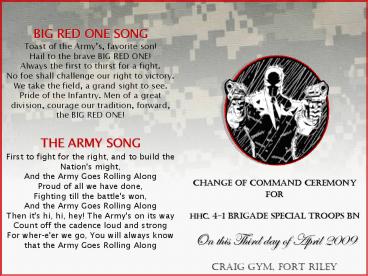CHANGE OF COMMAND CEREMONY - PowerPoint PPT Presentation
1 / 4
Title:
CHANGE OF COMMAND CEREMONY
Description:
... the 4th Brigade Special Troops Battalion was activated on January 16, ... a Battalion Staff Section, Support Platoon, CBRN Reconnaissance Platoon, ... – PowerPoint PPT presentation
Number of Views:620
Avg rating:3.0/5.0
Title: CHANGE OF COMMAND CEREMONY
1
VIGILANTES
BIG RED ONE SONG Toast of the Armys, favorite
son! Hail to the brave BIG RED ONE! Always the
first to thirst for a fight. No foe shall
challenge our right to victory. We take the
field, a grand sight to see. Pride of the
Infantry. Men of a great division, courage our
tradition, forward, the BIG RED ONE!
THE ARMY SONG First to fight for the right, and
to build the Nation's might, And the Army Goes
Rolling Along Proud of all we have done,
Fighting till the battle's won, And the Army
Goes Rolling Along Then it's hi, hi, hey! The
Army's on its way Count off the cadence loud and
strong For wher-e'er we go, You will always know
that the Army Goes Rolling Along
CHANGE OF COMMAND CEREMONY FOR HHC, 4-1 Brigade
Special Troops Bn On this Third day of April
2009 Craig Gym, FORT RILEY
2
HISTORY OF THE CHANGE OF COMMAND
HISTORY OF THE COMPANY
Constituted in the Regular Army on December 12,
2005, at Fort Riley, Kansas, the 4th Brigade
Special Troops Battalion was activated on January
16, 2006 with a Headquarters Section, a Battalion
Staff Section, Support Platoon, CBRN
Reconnaissance Platoon, and a Military Police
Platoon. Together these platoons bring
multi-dimensional support to the 1st Infantry
Division with their capabilities spanning all
tactical disciplines providing maintenance,
medical support, law enforcement, dining facility
operations, and CBRN reconnaissance.
Headquarters and Headquarters Company was
instrumental in the 1st Infantry Divisions
success during Operation Iraqi Freedom (OIF) V.
HHC remains ever vigilant in the Armys mission
and is ready at a moments notice to answer the
Nations call and show they are.... Trained and
Ready!
The
Change of Command
is a military
ceremony in
which the departing
commander
assembles
his troops for presentation to
the incoming
commander. The
ceremony serves to inform the
assembled
Soldiers and Officers
that they must respond to the
leadership of the new Commander. The history
of the Change of Command can be tracked back to
the year 406 B.C. when Lysander took command of
the Armies of Sparta. In the United States,
there have been three Ceremonies that have
influenced the ceremony that you are about to
witness. The first two involved George
Washington One when he assumed command of the
Continental Army beneath Washington Elm in
Cambridge, Massachusetts on 3 July 1775 The
other when Washington gave his personal farewell
to his Officers on 4 December 1783 at Faunces
Tavern In New York. At the conclusion of the
ceremony Washington passed between the ranks of
Guard of Honor to the wharf from which he
departed. A final event which influenced the
Change of Command Ceremony occurred on 10
November 1862, when Major General George
McClellan relinquished command of the Army of the
Potomac to Major General Ambrose Burnside. These
Ceremonies set the precedent for the modern day
Change of Command Ceremony, which involves the
traditional passing of the unit colors.
STB HQ
4
3
BATTALIONS DISTINCTIVE UNIT INSIGNIA
SEQUENCE OF EVENTS
FORMATION OF TROOPS COMMENCEMENT OF
CEREMONY NATIONAL ANTHEM INVOCATION CHANGE OF
COMMAND (PASSING OF THE GUIDON) REMARKS
BY COMMANDER, 4-1 BRIGADE SPECIAL TROOPS
BATTALION LTC OUTGOING COMMANDER CPT INCOMING
COMMANDER CPT CONCLUSION
Description A Gold color metal and enamel
device 1 1/8 inches (2.86 cm) in height overall
consisting of a shield blazoned Azure, in chief
two lighting bolts saltirewise Or, in base a bar
wavy Argent bearing a barrulet Celeste, overall a
tower Gules charged with a key ward to base of
the second below a mullet of the third. Attached
across the bottom of the shield is a Dark Blue
scroll inscribed with TRAINED AND READY in Gold
letters. Symbolism The dark blue gives
emphasis to the battalions support provided to
the Infantry Division as well as the other
battalions within the brigade. Gold is
emblematic of excellence and high achievement and
red is the color of valor and sacrifice. The
castle tower, adapted from the Corps of Engineer
branch insignia, represents the Engineer branch
and the mobility and survivability capabilities
that the battalion provides to the brigade. The
lightning bolts symbolize the communications and
electronic warfare elements of the units mission
and denote the timely support and modern
communications capabilities of the Signal branch.
The key refers to Military Intelligence and the
critical nature of the mission they provide to
support the commanders decision-making process
that is crucial to victory on the battlefield.
The star represents the command and control
capability that the unit provides to the brigade.
The wavy bars symbolize water and underscore the
units ability to deploy to any theater of war in
a timely manner. Background The distinctive
unit insignia was approved on 31 October 2005.
4
INCOMING COMMANDER CPT
OUTGOING COMMANDER CPT
Captain ..
Captain .































